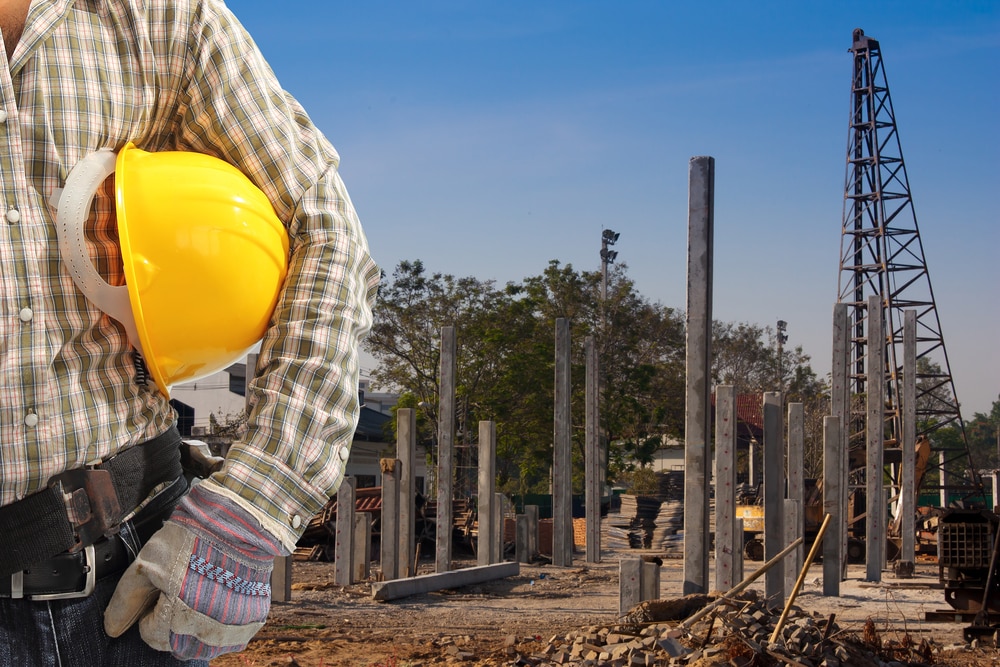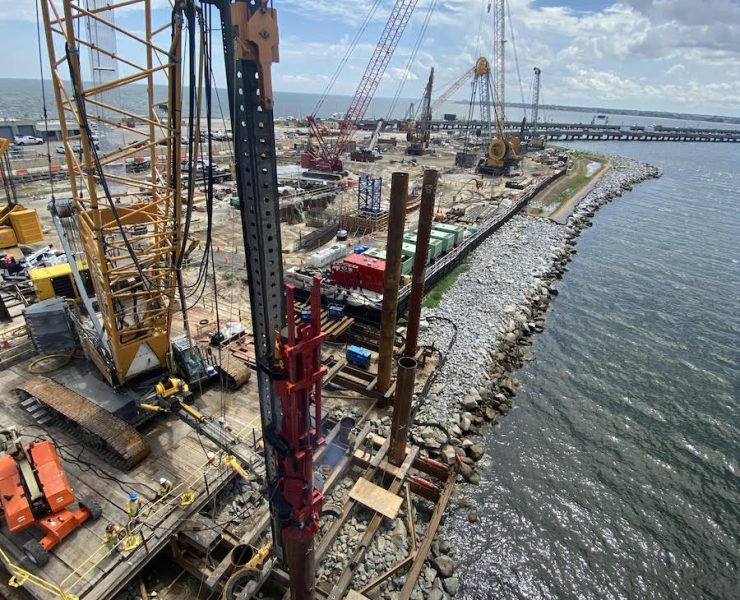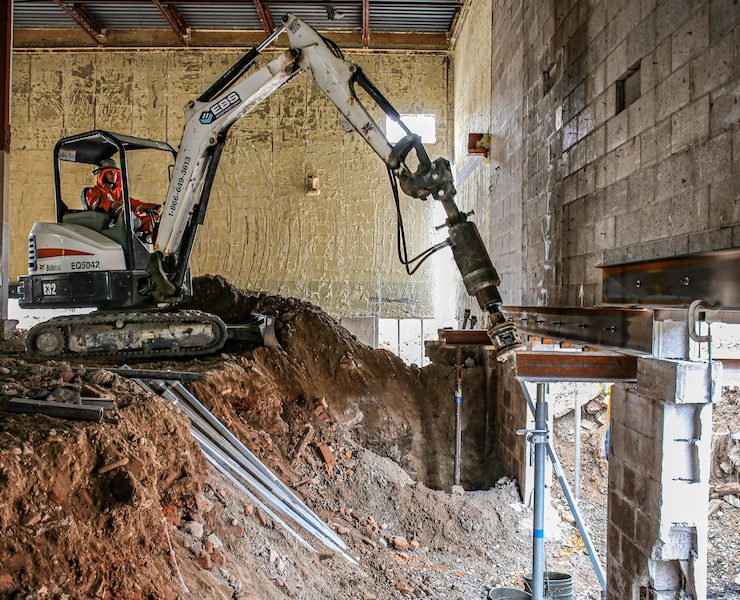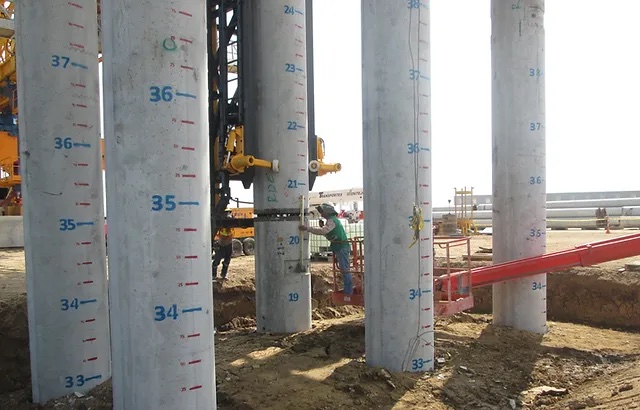Pile Driving Glossary


Adapters: Devices used to attach leads to the point of a crane boom.
Allowable load: The load which maybe safely applied to a pile based on bearing capacity and settlement.
Anchor pile: A pile used to resist tension or uplift loads.
Anvil: The part of a power-operated hammer, which receives the blow of the ram and transmits it to the pile.
Batter pile: A pile driven at an angle to the vertical.
Bearing pile: A pile driven or formed in the ground for transmitting the weight of a structure to the soil by the resistance developed at the pile point or base and by friction along its sides.
Bent: A structural member or framework used for strengthening a bridge or trestle transversely.
Bracing: A system of inclined or horizontal structure members fastened to the piles of a bent or a row to increase stability.
Brooming: Separation of fibers (usually at butt or tip of a timber pile) caused by improper driving.
Cast-in-place pile: A pile formed by excavating or drilling a hole and filling it with concrete.
Compaction pile: A pile driven to increase the density of very loose, cohesionless soil.
Composite pile: A pile formed of one material in the lower section and another in the upper.
Concrete piles: Piles made of concrete aggregate either cast-in-place or precast.
Concrete sheet piles: Reinforced precast piles of rectangular cross section with tongue-and- groove interlocks.
Cushion: A block inserted between the hammer and the top of the pile to minimize damage. Cushions can be wood, belting, old rope, or other shock-absorbent materials.
Dap: Incision or notch cut in timber, into which the head of a pile or other timber is fitted.
Diesel hammer: A stationary cylinder and a cylinder which is driven upward by a diesel fuel explosion. Open-end and closed-end types are used.
Dolphin: Piles driven close together in water and tied together. The group is capable of withstanding lateral forces from vessels and other floating objects.
Drop hammer: A weight with grooves in the sides, that falls on the end of the pile when driving.
Dynamic pile formulas: Equations which provide empirical determination of the approximate load-carrying capacity of a bearing pile, based upon the behavior of the pile during driving. The formula of principal value to the military engineer is the Engineering News formula.
End-bearing pile: A pile that derives its support from an underlying firm stratum.
Fender pile: A pile driven in front of a structure to protect it from damage from floating objects or to absorb shock from impact.
Floating pile drivers: Pile drivers mounted on barges, rafts, or pneumatic floats. A floating crane may be used as a pile driver when fitted with pile-driving attachments.
Follower: A member between the hammer and the pile to transmit blows to the pile when the top of the pile is below the reach of the hammer.
Fore-batter guide: A beam extending from the forward end of the frame of a steel-frame, skid-mounted pile driver to the leads.
Friction pile: A pile which derives its support from skin friction between the surface of the pile and the surrounding soil.
Guide pile: A pile which guides driving of other piles or supports wales for sheet piling.
H-piles: Steel H-sections used as bearing piles.
Heaving: Uplifting of earth, between or near piles, caused by pile driving. Also, uplifting of driven piles in such a mass of earth.
Helmet: A temporary steel cap placed on top of a concrete pile to minimize damage to the head during driving.
Jetting: A method of forcing water around and under a pile to loosen and displace the surrounding soil.
Lagging: Plates, strips, or blocks fastened to a pile to increase its load-carrying capacity.
Lead braces: Structural members used to fasten the leads to the base of the crane boom.
Leads: A frame (upright or inclined) which supports sheaves at the top for hoisting the pile and hammer. The leads are equipped with parallel members for guiding the pile and hammer. They may be fixed, swinging, or hanging, depending on how they are attached to the pile driver.
Log hammer: An expedient pile-driving hammer made up of hardwood and a steel base plate.
Moon beam: A slightly curved beam placed transversely at the forward end of the pile driver to regulate side batter.
Pile: Load-bearing member of timber, steel, concrete, or a combination forced into the ground to support a structure.
Pile bent: Two or more piles driven in a row transverse to the long dimension of the structure and fastened together by capping and bracing.
Pile cap: A masonry, timber, or concrete footing formed to transmit the load from the structure to the pile group.
Pile driver: A machine with a drop, steam, diesel, or pneumatic hammer with hoisting apparatus, leads, and frame for driving piles. The machine may be placed on skids, a float, a railroad car, or other mountings.
Pile-driving cap: A device placed on top of a pile to protect the pile and facilitate driving. It is also referred to as a pile-driving helmet.
Pile-driving hammer: See drop hammer and pneumatic or steam hammer.
Pile extractor: A device used to pull piles, usually an inverted steam or air hammer with yoke equipped to transmit upward pulls to the piles.
Pile foundation: A group of piles used to support a column or pier, a row of piles under a wall, or a number of piles distributed over a large area to support a mat foundation.
Pile group: Bearing piles driven close together to forma pile foundation.
Pile line: A line (rope or cable) to lift a pile and hold it in place during the early stages of driving.
Pile load test: A field load test conducted on a pile to determine its load-carrying capacity.
Pile shoe: A metal protection for the foot of a pile used to prevent damage or to obtain greater penetration when driving into or through hard stratum.
Pipe piles: Steel pipe sections used as bearing piles.
Pneumatic or steam hammer: A stationary cylinder and a moving part, (the ram) which includes the piston and striking head. Both single-acting and double-acting hammers are used.
Precast concrete piles: A reinforced or precast concrete pile cast and thoroughly cured before driving.
Rail piles: Steel railroad rails used as bearing or sheet piles in expedient situations.
Ram: The rising and falling part of the hammer which delivers the blow.
Refusal: The condition when a pile driven by a hammer has zero penetration (as when a point of the pile reaches an impenetrable stratum such as rock) or when the effective energy of the hammer blow is no longer sufficient to cause penetration (as when the hammer is too light or its velocity at impact is not adequate). The pile may cease to penetrate before it has reached the desired supporting power. “Refusal” may indicate the specified minimum penetration per blow.
Scour: The undermining of a pile foundation by the action of flowing water.
Set: The net distance by which the pile penetrates into the ground at each blow of the hammer.
Set-load curve: A curve showing the relationship between set and load for a given set of conditions and a given dynamic pile formula.
Settlement: The amount of downward movement of the foundation of a structure or a part of a structure under conditions of applied loading.
Soil profile: A graphic representation of a vertical cross section of the soil layers below ground surface,
Spliced pile: A pile composed of two or more separate lengths secured together, end to end, to form one pile.
Spotter: A horizontal member connecting the base of fixed leads to the base of the crane boom. The spotter can be extended or retracted to permit driving piles on a batter and also to plumb the leads over the location of a vertical pile.
Springing: Excessive lateral vibration of a pile.
Spud: A short, strong member driven and then removed to make a hole (for inserting a pile that is too long to place directly in the pile driver leads) or to break through a crust of hard material. Also a movable vertical pipe or H-section placed through a strong frame on a floating pile driver or dredge to hold the vessel in position.
Spudding: The operation of raising and dropping a heavy pile to break through a thin layer of hard material or an obstruction.
Steam hammer: See pneumatic or steam hammer.
Steel bearing piles: Rolled or fabricated sections used as piles.
Steel-frame, skid-mounted pile driver: A pile driver mounted on skids and made up of steel members.
Stringer: A member at right angles to, and resting on, pile caps or clamps and forming a support for the superstructure.
Tension pile: See anchor pile.
Test pile: A pile driven to determine driving conditions and required lengths. Also a loading test may be made to determine the load-settlement characteristics of the pile and surrounding soil.
Timber pile: A bearing pile of timber, usually straight tree trunks cut off above groundswell with branches closely trimmed and bark removed.
Timber pile driver: An expedient pile driver made up of dimensioned lumber.
Treated timber pile: A timber pile impregnated with a preservative that retards or prevents deterioration due to organisms.
Tripod pile driver: An expedient pile driver made up of local timber and usually hand operated.
Ultimate bearing capacity: The maximum load which a single pile will support. The load at which the soil cannot be penetrated.
Wakefield sheet piling: Timber sheet piles of three planks bolted or spiked together. The middle plank is offset, forming a tongue on one side and a groove on the other.
Wale: A member extending along a row of piles and fastened to them which serves as a spacer for the piles or support for other members. In a fender it absorbs shock and protects a structure or floating craft from floating objects. It is also called waler or ranger.

















